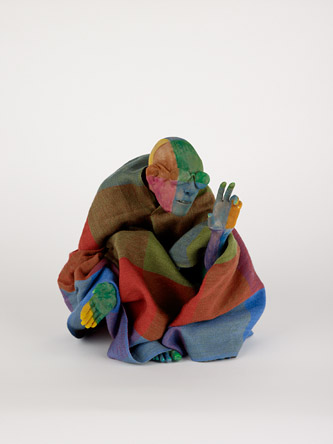John Hurrell – 28 February, 2010
Ornamentation here is paradoxically driven by reasons anti-social. For the dancer's private delight only.
Wellington
Francis Upritchard
Save Yourself
New Zealand at the 2009 Venice Biennale
26 February - 15 August 2010
Francis Upritchard’s Te Papa version of Venice’s Save Yourself accentuates a mindset extremely different from that provided by the Judy Millar installation. Her presentation celebrates inwardness, contemplating the interiority of The Self whilst fixating on acquiring an awareness of the parameters of the body. Her self-absorbed figures - with their slow solitary dance routines - explore tactility, various haptic sensations from the tips of various appendages (penises, metacarpals and metatarsals) and the covering surfaces of skin itself.
One sage lies on his back masturbating, others tap their palms with forefingers, explore the sensations of velvet cushions with their toes, blow across the narrow openings of vases, or gently move their limbs through the air, testing proprioceptive awareness of arm and leg placement and balance. Round shouldered, pot bellied and bow legged, the eyes of these unglamorous but perhaps wise introverts seem unseeing, except for one seated monk in sunglasses studying a palm held close to his eye.
Inner worlds, solipsistic mental states that caress the felt outside edges of each sentient creature’s living carcass, dominate. Even Upritchard’s silently balancing individuals, with decorative patterns painted delicately on their skin, seem unmotivated by the desire to appear attractive. Instead there is a need to activate the epidermal layer as neural sensation - the pleasure of cutaneous body surface, and the weight of thin fabric on the nape of the neck and the head and shoulders. Ornamentation here is paradoxically driven by reasons anti-social. For the dancer’s private delight only.
The interest in surface seems to be a metaphor also for an epistemological search, the desire for a reliable foundation for knowledge - not only for each person’s own grappling with experience but also all existence. The beautifully veneered, long wooden tables on which Upritchard’s figures stand seem to be a calculated trope for the world of material substance that sustains them both mentally and physically.
One figure, by itself on the last of the three tables, even mimics the painted branches of a truncated tree-trunk near which it stands, suggesting a family connection. This is the only occasion where one of these inner-body fixated, solo dancers acknowledges a presence beyond itself - an odd, amusing exception.
This is the best, most focussed Upritchard show I’ve seen, one that works better than the Venetian version with its inclusion of a Christ figure, many mirrors and a distracting ‘Given’ painted ceiling. Its inward ‘mental’ space is a perfect contrast to Millar’s architectural domination. To have these two very different artists together side by side is a better combination than I - for one - ever could have imagined.





 Two Rooms presents a program of residencies and projects
Two Rooms presents a program of residencies and projects Advertising in this column
Advertising in this column



This Discussion has 0 comments.
Comment
Participate
Register to Participate.
Sign in
Sign in to an existing account.